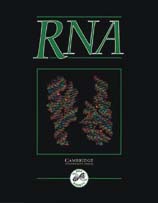Recognition of functional groups in an RNA helix by a class I tRNA synthetase
Published online by Cambridge University Press: 01 July 2000
Abstract
RNA helices that recapitulate sequences of the tRNA acceptor stem, including the 3′ NCCA nucleotides, can be substrates for aminoacyl–tRNA synthetases (Frugier et al., 1994; Hamann & Hou, 1995; Martinis & Schimmel, 1995; Quinn et al., 1995). Although the catalytic efficiency of aminoacylation of RNA helices is reduced from that of the full-length parent tRNA, the specificity is maintained. The specific aminoacylation lies in the ability of aminoacyl–tRNA synthetases to recognize functional groups within the RNA helices. Analysis of tRNA–synthetase structures has suggested a general principle (Rould et al., 1989; Ruff et al., 1991; Arnez & Moras, 1997). The class I synthetases, which attach an amino acid initially to the 2′-OH of the terminal ribose, approach the acceptor and NCCA end from the minor groove side. The class II synthetases, which attach an amino acid to the terminal 3′-OH, approach from the major groove side (Arnez & Moras, 1997). The class-specific approach leads to tRNA–synthetase complexes that are near mirror images of each other and provides a structural rationale for the stereochemistries of aminoacylation. We report here the identification of a functional group in the acceptor end of Escherichia coli tRNACys that is important for the class I cysteine–tRNA synthetase. This functional group makes one of the largest energetic contributions to aminoacylation. However, it is located on the major groove side of the acceptor stem. Kinetic analysis of the contribution of this functional group to aminoacylation suggests new features that are not anticipated from the class-specific approach of synthetases.
Information
- Type
- LETTER TO THE EDITOR
- Information
- Copyright
- 2000 RNA Society
- 2
- Cited by

